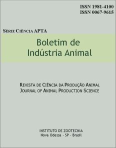Pyrethroid repellent effect on to bees in sunflower culture (Helianthus annuus)
Abstract
This research was carried out to observe the effect of some pyrethroid insecticides on bees. The experiments were set at the Department of Entomology of €œEscola Superior de Agricultura Luiz de Queiróz€, in Piracicaba, State of São Paulo, Brazil. Two experiments were set: 1. Six insecticides applied on the fiowers after 6 o€™clock pm at dosagens recommended for pest control (permethrin 75 ml/ha; deltamethrin 30 ml/100 litres; cypermethrin 125 ml/ha; fenvalerate 105 ml/ha; fenpropathrin 20 ml/100 litres; and esfenvalerate 40 ml/ha); 2. The insecticides permethrin, deltamethrin and cypermethrin appiied at double dosage early in the morning. The number of visits of bees on the flowers was observed during two minutes at three differents hours, before and after the insecticide applications. The statistical analysis of the results indicated that all the insecticides tested were repellent to the bees only for same hours.Downloads
Downloads
Published
Issue
Section
License
Os autores não serão remunerados pela publicação de trabalhos, pois devem abrir mão de seus direitos autorais em favor deste periódico. Por outro lado, os autores ficam autorizados a publicar seus artigos, simultaneamente, em repositórios da instituição de sua origem, desde que citada a fonte da publicação original seja Boletim de Indústria Animal. A revista se reserva o direito de efetuar, nos originais, alterações de ordem normativa, ortográfica e gramatical, com vistas a manter o padrão culto da língua e a credibilidade do veículo. Respeitará, no entanto, o estilo de escrever dos autores. Alterações, correções ou sugestões de ordem conceitual serão encaminhadas aos autores, quando necessário. Nesses casos, os artigos, depois de adequados, deverão ser submetidos a nova apreciação. As opiniões emitidas pelos autores dos artigos são de sua exclusiva responsabilidade. Todo o conteúdo deste periódico, exceto onde está identificado, está licenciado sob a Licença Creative Commons Attribution (CC-BY-NC). A condição BY implica que os licenciados podem copiar, distribuir, exibir e executar a obra e fazer trabalhos derivados com base em que só se dão o autor ou licenciante os créditos na forma especificada por estes. A cláusula NC significa que os licenciados podem copiar, distribuir, exibir e executar a obra e fazer trabalhos derivados com base apenas para fins não comerciais.













